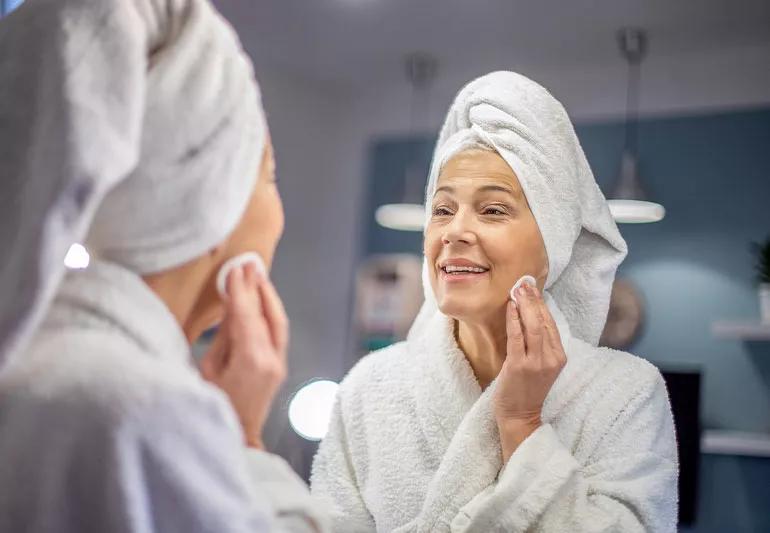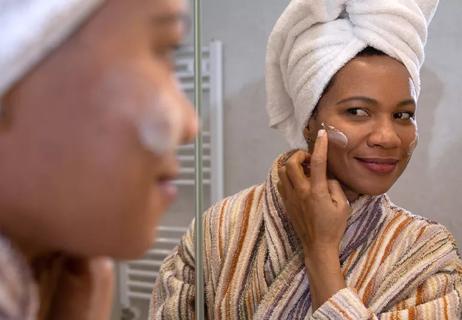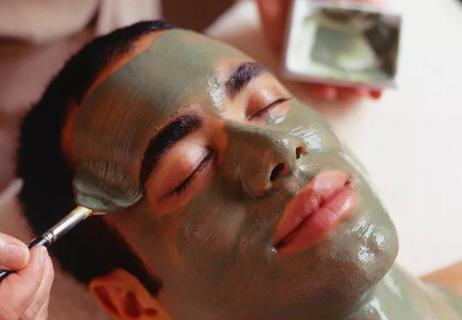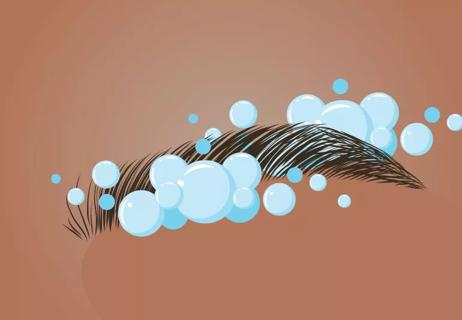New formulas are less drying and contain water-based and skin-loving ingredients

TV shows and movies tend to get the reboot treatment — new and improved characters, plotlines and backstories.
Advertisement
Cleveland Clinic is a non-profit academic medical center. Advertising on our site helps support our mission. We do not endorse non-Cleveland Clinic products or services. Policy
When it comes to skin care, toner is back in the starring role thanks to its evolution from an alcohol-based solution to one that has skin-loving ingredients to target different skin types and concerns.
Gone are the harsh formulas that left your skin dry and irritated. This new class of toners is water-based, soothing and, in some cases, can brighten and fight aging, leaving your skin feeling clean and hydrated.
Dermatologist Alok Vij, MD, breaks down how a face toner works, when to use it and how to find the best one for you.
A toner is typically a water-based lotion or tonic that you use after cleansing and before moisturizing. While it may look and feel like water, it does a lot more — think of it as a primer for the rest of your skin care routine. A toner may also be called a tonic, exfoliating acid or an essence.
“Previous generations of toners were used to get rid of any residual impurities or extra oil left on your skin that weren’t able to be removed with a cleanser,” explains Dr. Vij. “They tended to be very high in alcohol content, which tends to be really drying. Today’s toners are more moisturizing and soothing. They prep your skin for additional cosmetics and products that come afterwards rather than just stripping away oil and grime.”
Advertisement
You can find a variety of toners at stores or online. Some are infused with peppermint, aloe or eucalyptus to help soothe skin.
And don’t mistake a toner for an astringent. Astringents are usually alcohol-based and used to control oil — but they can be harsh and dry out your skin. A toner gently refreshes your skin without stripping it of moisture.
So. what does toner do for your face? It removes any dirt or grime that remains after cleansing, but does so gently.
And toners help prep your skin for those products you’re putting on after — think serums, moisturizers, night creams, etc. The outer layer of your skin is a mixture of oils and proteins. When you wash your face, you’re removing any dirt and dead skin, which can cause the outer layer of your skin to feel dry.
“When you apply a toner immediately cleansing, you’re increasing the water content of that outer layer of skin, which is better for the absorption of additional products afterward,” notes Dr. Vij. “It kind of acts like a sponge by helping those other skin care ingredients sink in.”
Other face toner benefits include:
And how quickly should you expect to see results from using a toner?
“It usually takes at least six weeks to three months to see any effect from using a toner,” he continues. “The improvement may be subtle, but toners really make everything else work better.”
If your toner is designed to help prevent acne or reduce hyperpigmentation, then you may see results in about two to three months. And Dr. Vij says that you may see more of a payoff long-term from using a toner, especially if it has anti-aging ingredients.
“You may not see an immediate difference. It’s over the course of a few years that you’re not seeing your skin age,” he notes.
When you think about applying your skin care products, Dr. Vij recommends starting with the lightest texture or thinnest consistency, then working your way up to products that have the thickest consistency.
“A toner should be used after cleansers because it’s water-based,” he advises. “Sometimes, toners come in a spray form, so you can mist it onto your face directly. Sometimes, they’re applied with a cotton ball, swab or round.”
When it comes to how to apply toner, it couldn’t be easier. All you need to do is gently swipe the toner over your face after cleansing. No need to wash off.
Advertisement
And when to use toner is up to you — you can use a toner once or twice a day.
“You can fit it into your routine based on how your skin is tolerating the product and what other products or moisturizers you use,” Dr. Vij suggests. “Some people only do their skin care routine once a day and don’t need to necessarily add a second step or a second component of their routine.”
As with many skin care options there isn’t a one-size-fits-all product out there. Toners come in a variety of formulas that cater to your skin tone, type and concerns.
“It’s important to look at the ingredient list. First, look to see if there’s any alcohol used and if so, how much,” Dr. Vij says. “A small amount of alcohol can be good for people with oily skin or who have acne.”
Here’s what to look for or avoid based on your skin needs:
Advertisement
If you’re looking to up your skin care game, adding a toner can be beneficial.
“There are so many toners out there on the market. And a bunch of them are marketed for any skin problem that you have from acne-prone skin, rosacea-prone skin, dry skin or oily skin,” says Dr. Vij. “There’s a toner for almost everybody.”
Advertisement
Learn more about our editorial process.
Advertisement

Pantothenol is a powerful moisturizer and can help repair damaged skin and hair

This alternative to retinol may be easier on sensitive skin

Day creams should protect your skin, night creams should soothe and repair it

Pure cocoa butter can help keep your skin supple, with a subtly delicious scent

Focus on the philosophy — replenishing and respecting your skin — not necessarily the steps

Lie back and relax as a skin specialist cleanses, exfoliates and hydrates your skin

The powerhouse oil fights fine lines and wrinkles, soothes sunburn and a whole lot more

From icing to taping, experts chime in on what’s worth trying and what’s better off skipping

Type 2 diabetes isn’t inevitable with these dietary changes

Applying a hot or cold compress can help with pain